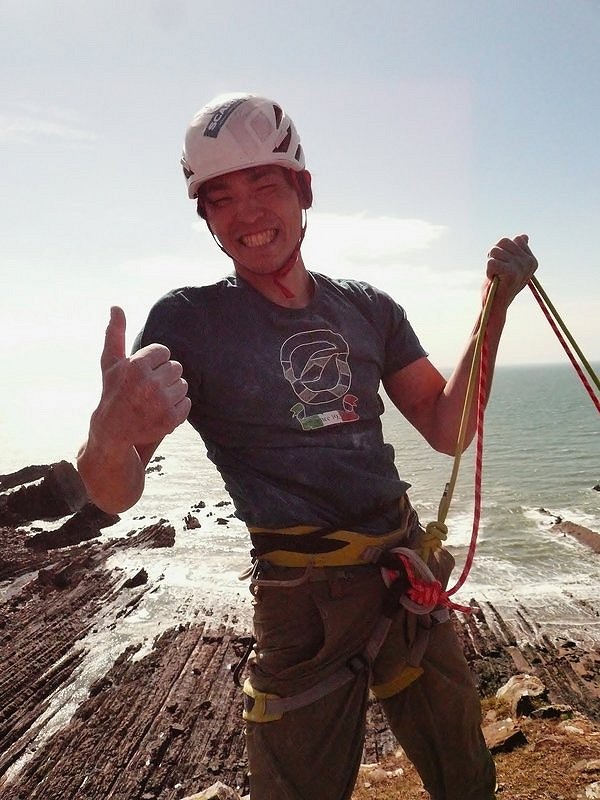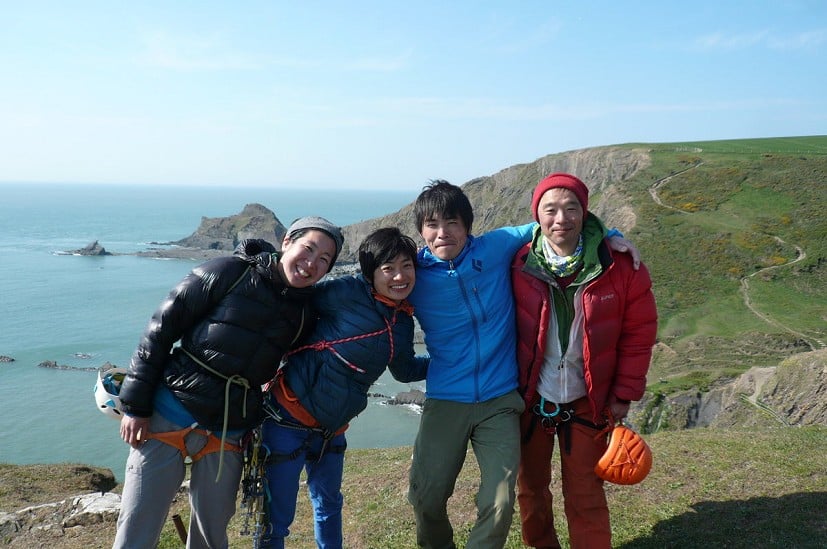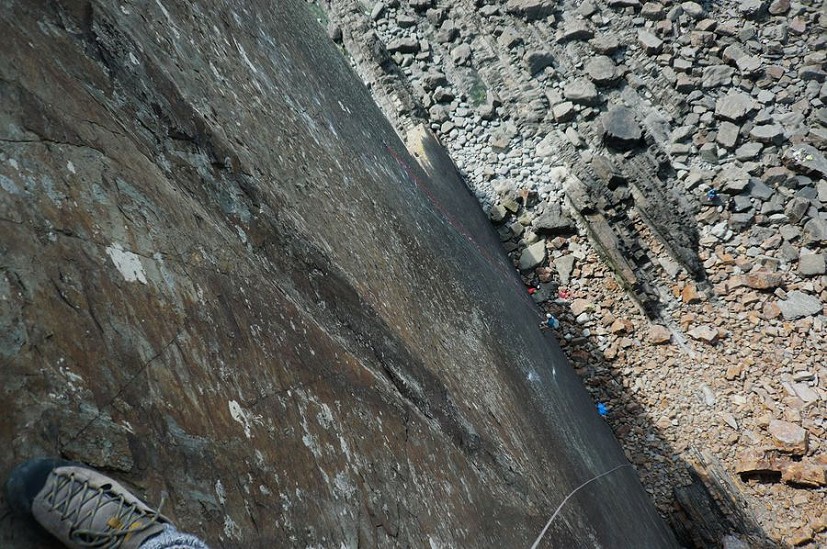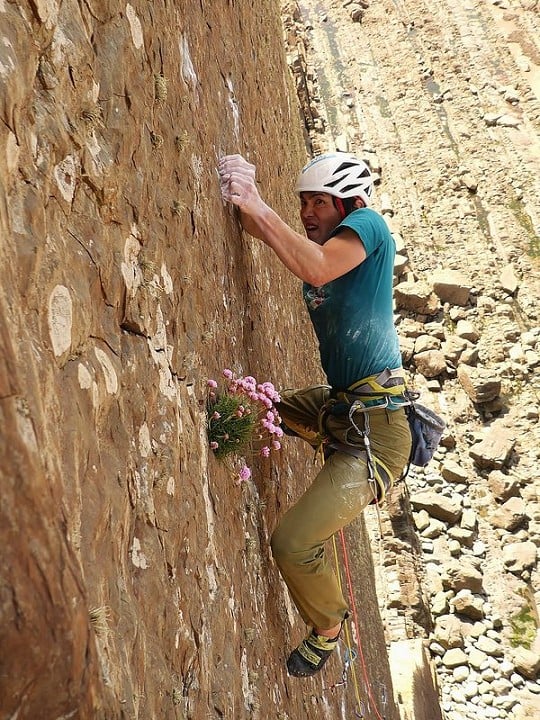
Japanese climber Keita Kurakami repeated The Walk of Life E9 6c at Dyer's Lookout, Devon on 13th May 2017, as reported on UKC by local Stu Bradbury, who witnessed Keita's ascent and took photos.
The following discussion was conducted in person and recorded by Masa Sakano at Dyer's Lookout shortly after his ascent.
Masa belayed Keita on both of his two attempts, as well as offering help for preparation and logistics. He has very kindly translated the interview from Japanese for us to share.
How did you come to know about The Walk of Life?
I saw it on alpinist.com and UKC news when James Pearson made the first ascent and the grade of E12 was given. In fact, I was just bouldering at that time, perhaps for 98% of the time, but the route caught my attention and I put it in my wish-list folder on my computer. Since then, the route stayed in the folder for ten or so years, though I didn't think I would ever have a chance to get on it one day!
What brought you to the UK? Was climbing The Walk of Life the only reason? Or, did you have something else to do?
I am here to attend the BMC International Meet. I heard it would be held in Cornwall, and realised that The Walk of Life is pretty much on the way to the meet. I wanted to take on the challenge, or even just have a look, especially since I heard the weather would not be great.
So, you came to the UK a few days before the meet?
Yes, I came about a week before the meet.
Is it your first climbing trip to the UK?
No, I visited the UK last January in the Peak District. I climbed Gaia E8 [Black Rocks]. It was just for 5 days, but I noticed that when I stood at the top of routes, there were no bolts where there usually are in Japan. I was really impressed with that and wanted to return to the UK.
Had you done any homework about The Walk of Life?
Yes, I had. You [Masa] gave me a great deal of information, and I read the account by the fourth ascensionist [Charlie Woodburn] on UKC. I don't usually do research before a climb, and prefer to just climb a route and see how it goes. But this time, I did my homework!
Did you do any particular preparation to climb the route?
I heard from the second ascensionist, Dave MacLeod, that a pecker would be needed. I also heard lots of Ball Nuts would be necessary, so I borrowed lots of Ball Nuts from my friends in Japan, and bought peckers.
How were you feeling before the climb?
I had caught a cold a week before travelling to the UK, and after the first day [of looking at the route and practising] the cold came back, so I just stayed and slept in a B&B the following two days.
Sounds like tough luck! What was your first impression when you saw the route for the first time?
I had heard that the route is about 50m long. But when I first saw it, it was much longer than I had imagined. I have climbed a 48m pitch big-wall in Yosemite, but nowhere else, and indeed none in Japan. I thought headpointing it would be tough.
Then, when you got on the route, was there any change in your thoughts about the route? Or, was it similar to what you had first felt?
Well, I'd heard the moves in the first part are hard, really hard, but when I actually got on, I worked out all the moves on the first day. They weren't too bad. Rather, I found the upper part was quite hard. I found the weight of the ropes to be significant. In fact, I'd hardly had any experience of using double ropes before! [laughs]. I thought headpointing the route would be a difficult task, in a different way than I expected.
How were the moves and climbing on The Walk of Life?
I would say a bystander who watches a climber on it would think he is repeating similar moves again and again. I found the footwork to be very important. Delicate and complicated footwork was key and to memorise all of the moves was tough, or I found it to be near impossible.
What did you think of the grade?
This route was definitely harder than Gaia. In that sense, it was harder than E8. However, I have never climbed any other E9s and have climbed only one E8, and so I can't tell. In terms of the sport grade, it was about 5.13d/8b.
How was the rock? Were you familiar with the rock type?
Not at all! It was a really strange type of rock.
How was the gear? How was the belay [to set up the top rope]?
The gear wasn't too bad, I think. There was a decent amount of gear, though it was not perfect. In particular, the first 10m was poor just as I heard, but there was a pecker. Instead, I was scared of the stake belay at the top. You must be joking to make a belay with these, I thought! [laughs].
You headpointed the route. What was your strategy?
When I first saw the route, I immediately gave up the idea of onsighting. No chance. Then, I chose to headpoint it, meaning I would practise the climb before climbing it properly.
How many days did you spend on the route?
Four days in total. I succeeded in redpointing on the fourth day.
[Note: Keita's first head-point attempt was on the third day, but he took a fall. Three days later he got on the route again, practised and then successfully headpointed it in the afternoon.]
How were the tides?
The tides weren't too bad, but I have never experienced climbing anywhere before where I would have to consider the tides!
When you first got on the route, how was it?
On the first day, the purpose was to work and check out the moves and gear. I didn't plan to climb it on the day.
I found the moves to be not too bad and worked out all the individual moves on the first day. However, it was a long route.
How was your first headpoint attempt on Wednesday?
I had practised all the moves by that time and thought I must give it a go. I thought I would make it as I reached a point high on the wall, but a foothold broke off and I took a 20m fall.
Did you get injured?
Not much. Just a bit of rope burn and some bruises.
What was the gear that popped? [The top two pieces of gear popped off.]
A ball nut and micronut.
Have you ever had such a massive [20+m] fall before?
No, never.
Your girlfriend was watching, right?
Yes, she was. I tried not to think about it.
After the fall, did you still want to try it again?
I first thought my challenge would be over, but then eventually I decided that I could try again.
How was the recovery of your injuries [between Wednesday and Saturday, the day of the successful ascent]?
Yes, they had healed enough.
How were the conditions on the successful attempt?
I think it was as good as it could have been. Yes, the rock was dry.
The forecast said it would be showery in the morning, and get better in the afternoon, then rain would start at around 5pm. It was sunny in the morning, but on our walk out it started raining, as forecast. It was a little windy, and the ropes were flapping in the wind, but apparently it didn't affect my climbing. In terms of the temperature, it was a little cold so the belayer was wearing a down jacket, and I started climbing with a windproof on, which I took off after the initial 10m and climbed the rest with only a T-shirt. After the two rainy days, all the chalk in the lower half was washed away, while the chalk in the upper half remained. I just about managed to remember the moves in the lower half.
On your first attempt, a foothold broke off. What did you find on the hold and the move there, when you got back on it?
The foothold was still there, though much smaller. The grade stayed the same, there was no big difference.
What was in your head during your second attempt?
I just didn't want to fall.
How did you feel immediately after you had topped out?
I thought "Great, I made it!!"

After completing The Walk of Life, what did you think of it? Is it a good route?
It is a tremendous route, no question!
Do you think someone may onsight it one day?
I think it would be difficult, but of course I can never say never. I wish I could see someone onsight it in my lifetime.
Changing the subject, what do you think about trad climbing in the UK?
It's complex. The way people consider the ethics, and talk about it, not in a snobbish way, but just casually talking about the ethics - I am impressed with it. It seems that it's not just about moves or the climbing itself, but the ethics also play an important part.
Would you like to come back to the UK?
Definitely!
Do you have any next objectives in your mind?
I have many routes on my wish list in both the UK and Japan. In the UK, I would like to have a look at Rhapsody E11 at Dumbarton Rock.
Finally, do you have anything else to add?
I couldn't have made it without many people's help. Stu [Bradbury] gave me some tips about the route and took photos of my climbing. Sayaka Masumoto kindly accompanied me. She said "No question, you must do it!" [laughs], but she cheered me on. Katano-san, who lives is the UK and is my girlfriend, was really supportive.
Dave [Wynne-Jones] kindly let us doss at his place the day before yesterday. Finally, big thanks goes to Masa Sakano.
Thank you very much!

















Comments